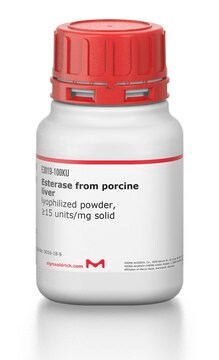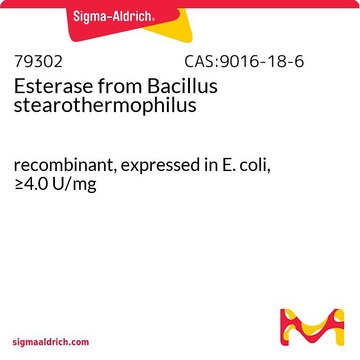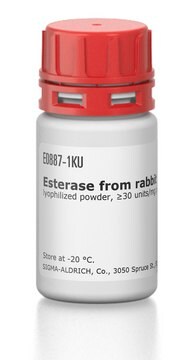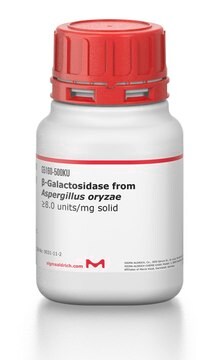96667
Esterase from Bacillus subtilis
recombinant, expressed in E. coli, ≥10 U/mg
Synonyme(s) :
Carboxylesterase
Se connecterpour consulter vos tarifs contractuels et ceux de votre entreprise/organisme
About This Item
Produits recommandés
Produit recombinant
expressed in E. coli
Niveau de qualité
Forme
crystalline
crystals
powder or flakes
Activité spécifique
≥10 U/mg
Température de stockage
−20°C
Vous recherchez des produits similaires ? Visite Guide de comparaison des produits
Description générale
Esterase belongs to the hydrolase superfamily of enzymes.This recombinant esterase contains a C-terminal histidine tag.
Application
Esterase, from Bacillus subtilis, may be used in protein engineering research as well as to study the kinetic resolution of acetates of arylaliphatic tertiary alcohols. Product 96667 is recombinant and expressed in E. Coli (≥10 U/mg).
Actions biochimiques/physiologiques
An esterase is a hydrolase that splits esters into acids and alcohols.
Esterase participates in the stereospecific hydrolysis and production of esters. Esterases, that are obtained from cultured bacteria and fungi has several industrial applications.
Conditionnement
Bottomless glass bottle. Contents are inside inserted fused cone.
Définition de l'unité
1 U corresponds to the amount of enzyme which converts 1 μmol 4-nitrophenyl-L-acetate per minute at pH 7.5 and 30°C.
Mention d'avertissement
Danger
Mentions de danger
Conseils de prudence
Classification des risques
Resp. Sens. 1
Code de la classe de stockage
11 - Combustible Solids
Classe de danger pour l'eau (WGK)
WGK 1
Point d'éclair (°F)
Not applicable
Point d'éclair (°C)
Not applicable
Faites votre choix parmi les versions les plus récentes :
Déjà en possession de ce produit ?
Retrouvez la documentation relative aux produits que vous avez récemment achetés dans la Bibliothèque de documents.
High-Resolution Fractionation Processes
Separation Science and Technology, 1, 61-99 (1998)
Soil-based gene discovery: a new technology to accelerate and broaden biocatalytic applications
Gray K A, et al.
Advances in Applied Microbiology, 52, 1-28 (2003)
New citation. Highly Enantioselective Synthesis of Arylaliphatic Tertiary Alcohols using Mutants of an Esterase from Bacillus subtilis
Robert Kourist, Sebastian Bartsch, et al.
Advanced Synthesis & Catalysis, 349, 1393-1398 (2007)
Birgit Heinze et al.
Protein engineering, design & selection : PEDS, 20(3), 125-131 (2007-02-21)
Enzyme-catalyzed kinetic resolutions of secondary alcohols are a standard procedure today and several lipases and esterases have been described to show high activity and enantioselectivity. In contrast, tertiary alcohols and their esters are accepted only by a few biocatalysts. Only
Jessica Lusty Beech et al.
RSC advances, 12(13), 8119-8130 (2022-04-16)
Esterase enzymes catalyze diverse hydrolysis reactions with important biological, commercial, and biotechnological applications. For the improvement of these biocatalysts, there is a need for widely accessible, inexpensive, and adaptable activity screening assays that identify enzymes with particular substrate specificities. Natural
Notre équipe de scientifiques dispose d'une expérience dans tous les secteurs de la recherche, notamment en sciences de la vie, science des matériaux, synthèse chimique, chromatographie, analyse et dans de nombreux autres domaines..
Contacter notre Service technique









